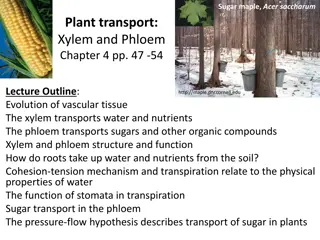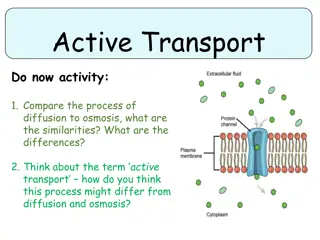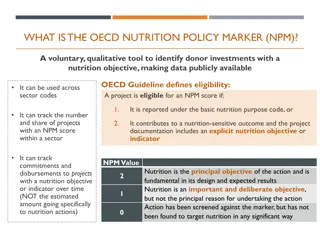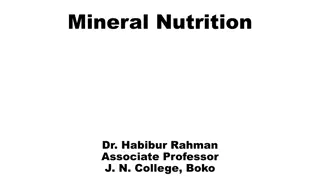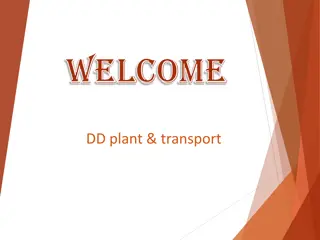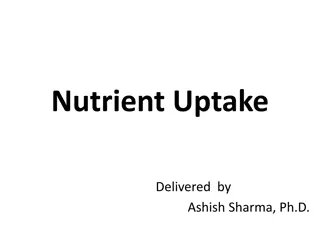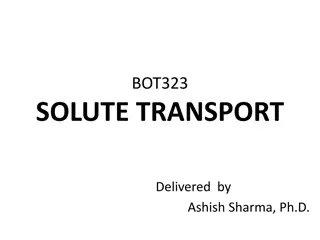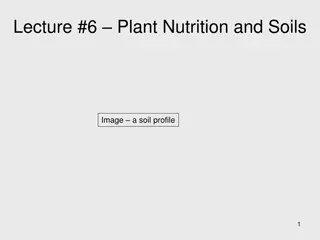Understanding Plant Transport, Nutrition, and Responses
The process of how plants transport nutrients and respond to their environment is demonstrated through labs focusing on protein transport, water absorption by roots, and control of transpiration using mechanisms like diffusion, osmosis, and symbiotic relationships with fungi. Various components in plants like plasmodesma, tonoplast, and vacuoles play essential roles in nutrient transportation. The interaction between cells, xylem sap flow, and stomata regulation are crucial for plant health and growth.
Download Presentation

Please find below an Image/Link to download the presentation.
The content on the website is provided AS IS for your information and personal use only. It may not be sold, licensed, or shared on other websites without obtaining consent from the author. Download presentation by click this link. If you encounter any issues during the download, it is possible that the publisher has removed the file from their server.
E N D
Presentation Transcript
Transport in plants, plant nutrition, plant responses Obj: TSW understand and demonstrate how plants transport nutrients, and respond to their environment by doing two plant labs.
Transport proteins- proteins embedded in the cell membrane, diffusion Selective channels allow certain ions through, bot not others, K+, not Na+ *Proton pump hydrolyzes ATP & uses the released energy to pump hydrogen ions (H+) out of the cell. H+ outside the cell, making a membrane potential (charge), inside the cell becomes more negative. Cotransport drives the transport of different solutes (H+ downhill, & NO3- uphill) for the uptake of sucrose by plant cells. Chemiosmosis unifying principle of cellular energetics Osmosis passive movement of water Water Potential ( )= solute concentration & pressure (cell wall) Aquaporins affects the rate at which water diffuses, does not affect the water potential gradient or direction of water flow Selective Permeability
Vacuolated plant cell have three major components Plasmodesma connect compartments cytosolic of neighboring cells to form that are continuous to transport certain molecules Tonoplast regulates molecular traffic between the cytosol & vacuolar contents- sap Symplast , first compartment tissue level, cytoplasmic continuum Apoplast- second compartment at the tissue level, cell wall Vacuole not shared with neighboring cells
Absorption of water & minerals by roots Mycorrhizae symbiotic relationship between the roots of plants and hyphae (filaments) of the fungi, increasing the surface area for the absorption of water and minerals. (mutualism) Xylem sap flows upward towards leaves, this flow upward brings mineral nutrients to the up the plant also. Root pressure of water pushes water up the plant only a few meters. Transpiration- provides the pull, water properties such as cohesion of water due to hydrogen bonding transmits the upward pull of water through the plant. Stomata microscopic pores on the surface of the leaf Transpiration - the loss of water vapor from leaves Bulk Flow long distance transport of water
Control of transpiration Guard cell mediate the photosynthesis transpiration compromise Guard cells control the size of the stomata, which controls transpiration, conserves water and with it the requirement for photosynthesis CO2diffuses into the leaf through the stomata, O2(by-product) diffuses out. Transpiration to photosynthesis ratio the amount of water lost/gram of CO2assimilated into organic material by photosynthesis C3 plants ratio 600:1 C4 plants (corn) ratio 300:1 Transpiration also allows for evaporative cooling, so enzymes do not denature Changes in turgor pressure open and close the stomata due to accumulation of K+ Opens guard cells, exodus of K+ decreases osmotic pressure and stomata close
Translocation of Phloem sap Translocation the transport of sugar through the plant. Sugar sink - an organ that is a net consumer or storer of sugar. Roots, shoots, stems, fruit, tuber or bulb Phloem sap moves by bulk flow (pressure)
Macronutrients & Micronutients Major components of plant organic compounds: Carbon, Oxygen, Hydrogen, Nitrogen, Sulfur, Phosphorus, Potassium, Calcium, Magnesium Minor components of nutrition, (cofactors of enzymatic reactions) : Chlorine. Iron, Boron, Manganese, Zinc, Copper, Molybdenum, Nickel Fertilizer: N:P:K
Nitrogen Fixation & Symbiotic Relationships Nitrogen fixation: Bacteria restock nitrogenous minerals in the souk by converting N2 to NH3 (ammonia) Enzyme nitrogenase catalyzes the reaction to reduce N2 to NH3 by adding electron along with hydrogen ion. Ammonia pick up another hydrogen to form ammonium (NH4+) that plants absorb. (NO3-) nitrate, produced in soil by bacteria that oxidize ammonium Once it is absorbed, the plant can reduce it back to ammonium to be used for amino acids Mycorrhizae modified roots (fungi) Parasitic relationships Mistle toe & oak trees, aphids & roses Carnivorous Plants venus fly trap
Plants respond to external & internal cues Plant have Cellular receptors to detect important changes in the environment Hormones- coordinate growth, development & responses to environmental stimuli Trophism to grow in a certain way Phototropism - growing toward the light Auxin cell elongation Cytokinins stimulate cell division & differentiation Gibberellin stimulate growth in both leaves & stem, little effect on root Ethylene hormone plant produced in response to stress (drought, flooding, mechanical pressure, injury or infection) Ethylene helps with the programmed destruction of cells, organs and the whole plant
Plant responses Apoptosis programmed cell death Very busy time, require new gene expression Newly formed enzymes break down many chemical components: chlorophyll, DNA, RNA, Proteins, Membrane lipids Phototropism- growth toward light Circadian rhythms internal clock Photoperiodism Short day plants- flowers when nights are long Long day plants flowers when nights are short Gravitropism roots growing downward into the soil, stems exhibit negative gravitropism Trigmotropism touch sensitive Plant defense physical defense- thorns Chemical defense distasteful, poisonous (toxic), airborne attractants that bring animals that destroy herbivores
tropism Transpiration stomata guttation Phloem auxin Osmosis Xylem epidermis Bulk Flow macronutrients ethylene
Quick Write- Transpiration Describe transpiration, include the part of the plant that are involved. Explain how transpiration works and why it is important.
Transpiration Just mL water loss (or gain) in each plant 1.2 1 Light 1 Humidity 0.8 Heat Light 2 0.6 Light 3 0.4 Wind 1 Wind 2 0.2 Wind 3 0 Plant 1 Plant 2 Plant 3 Plant 4 Plant 5 Plant 6
Transpiration Chart Title 1.2 1 Light 1 0.8 Humidity mL/m2 Water Loss Heat Light 2 0.6 Light 3 Wind 1 0.4 Wind 2 Wind 3 0.2 0 Plant 1 Plant 2 Plant 3 Plant 4 Plant 5 Plant 6
Symbiotic Relationships p. 42 Identify & Describe a type of symbiotic relationship involving plants, and how each organism benefits. How is this important to coevolution?
Lab #9 Transpiration Choose 1 or the 2 methods to determine the water loss in mL/m2 Leaf Trace Method Total surface area is calculated by dividing the total number of blocks coved by 4. ____ = Leaf surface area (m2) Leaf Mass Method Cut 1cm2 section out of a leaf Mass the leaf Multiple the section by 10,000 to calculate the g/m2. Divide the total mass of the leaves by the g/m2 = 83g/m2_____ = leaf surface Area (m2) Water Loss:m2 Wind 1.7mL; Light1.7 mL; Heat & Light .7mL; Humidity .7mL Wind:14.16 mL/ m2; Light: 14.33mL/m2; Heat & Light 9.39 mL/m2; Humidity: 8.07mL/m2 Record your data in Table 9.2 for the 0 value and the 30 minute value
Final Mass of Leaves Wind 10.7g Light 11.9 g Heat & Light 7.8 g Humidity 6.7 g
Quick Write Discuss some hormone effects on plants, give examples and explain how they work, why are they important?
Lab # 12 1. 1st measure Dissolved Oxygen of 3 different temperatures of water. Which one holds more O2? 2. 7 Groups of students. Materials: GLX, Temperature probe, Dissolved Oxygen Sensor & Absolute Pressure Sensor, 1 small beaker 3. Hook the 3 probes into the GLX and turn it on. 4. Press home, press right arrow to select the Digits button, press the checkmark, then Press F2 to see all three values of the probes. 5. At a temperature of 25 C and a barometric pressure of 760 mmHg, 8.2 mg of oxygen will dissolve in one liter of water at 100% saturation.
DO mgO2/L at cold temp, Room Temp and hot temp. Chart Title 8 7 6 5 Cold Water 4 Room Tem Water 3 Hot water 2 1 0 Group 1 Group 2 Group 3 Group 4 Group5 Group6
Table 12.2 Class Mean Data Productivity 7 6 5 4 Series 1 3 Column1 2 Series 3 1 0 Group 1 Initial Reading Group 2 Dark Group 3 100% Group 4 65% Group 5 25 % Group 6 10% Group 7 2%
Lab #12 part b Obtain 3 vials/ group, there should be 7 groups. Group 1 I initial Get average today only. Dennison Group 2 D dark (Aluminum Foil) Amrita Group 3 100% (No screens) Chris Group 4 65 % (1 screen) Jai Group 5 25 % (3 screens) Jenna Group 6 10% (5 screens) - Tu Group 7 2% (8 screens)Anna Average the DO for the three vials, after24 hour period.
Quick Write P. 48NB What does it mean to have primary productivity in a photosynthetic plant?
Class Data Mean Productivity Table 12.4 # of Screens % Light Gross Productivity Net Productivity Respiration 0 100 .3 mgO2 /L 6.6 5.03 = 1.62mg O2/L 6.6 5.33 = 1.27mg O2/L 6.6 4.9 = 1.7 mg O2 /L 6.6 3.37 = 3.23 mgO2/L X 6.6 3.32 = 3.28 mgO2/L 1 65 X 3 25 X 5 10 8 2 X Initial DO value: 6.6 mgO2/L x .698 = 4.607 mL O2/L x .536 = 2.469 mg carbon fixed/L Dark DO Value: 6.3mg O2 Net Productivity = .3mg O2/L Independent Variable: Dependent Variable: *A lake becomes eutrophic when mg carbon fixed/L = 85
Lab #12 Questions 1. Primary Productivity can be measured by the rate of O2 production, Rate of CO2 uptake, rate of carbohydrate or biomass. 2. The relationship is that for each milliliter of oxygen produced, .536 milligrams of carbon is assimilated. 3. The relationship between temperature and dissolved oxygen is an inverse one. As the temp. ina liquid rises, the amount of gas that remains dissolved in the liquid decreases. The most oxygen rich water is shallow, rapidly moving, and cold. 4 C, water can hold approximately 19% oxygen.
4. No gross productivity: No net productivity: 5. Water is much thicker than air. This means that the gill muscles must work much harder to move water over the gill s surfaces. Another factor is that water holds much less oxygen than air does. 6. You would expect a higher DO reading in a stream than a lake, tumbling action of water over rocks and shallowness increases O2 content. 7. DO at 7 am is lower than the DO at 5 pm. DO is decreased by respiration of organisms at night, the low levels of light in early morning do not produce as much DO through photosynthesis, as it would later in the day.
8. A would have more oxygen available to the fish. At a particular temperature, only a fixed amount of oxygen could be dissolved in a given volume of water. Since the volume of water is greater, the amount of oxygen dissolved in water would be greater. However, Over the course of the day, the fish would use up the DO in both containers, and the one with more surface area (B) would better sustain the fish.
9. Eutrophication is the increase in concentration of fertilizers such as Nitrogen, Phosphorus, and other nutrients in the bodies of water. By increasing the amounts of these nutrients in bodies of water the types of organisms that are most successful or that have the greatest biomass change. The changes effect the entire ecosystem. Tremendous blooms of algae happen, then they produce large amounts of oxygen during the day, but respire at night and depletes the DO content. The dense algae decrease available light in the photic zone causing anoxia in deeper water. The algae eliminate the natural food of herbivores.


